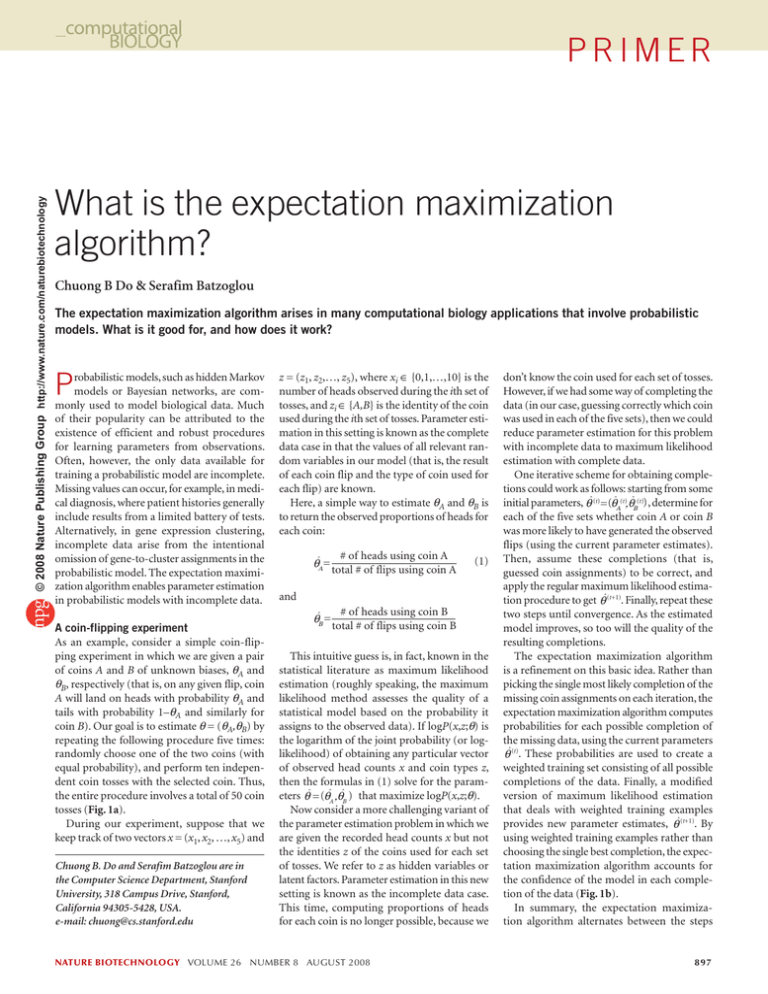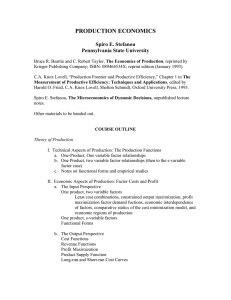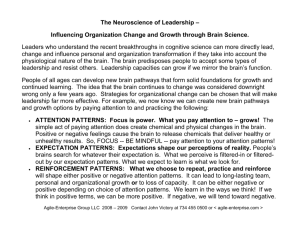What is the expectation maximization algorithm?
advertisement

© 2008 Nature Publishing Group http://www.nature.com/naturebiotechnology
primer
What is the expectation maximization
algorithm?
Chuong B Do & Serafim Batzoglou
The expectation maximization algorithm arises in many computational biology applications that involve probabilistic
models. What is it good for, and how does it work?
P
robabilistic models, such as hidden Markov
models or Bayesian networks, are commonly used to model biological data. Much
of their popularity can be attributed to the
existence of efficient and robust procedures
for learning parameters from observations.
Often, however, the only data available for
training a probabilistic model are incomplete.
Missing values can occur, for example, in medical diagnosis, where patient histories generally
include results from a limited battery of tests.
Alternatively, in gene expression clustering,
incomplete data arise from the intentional
omission of gene-to-cluster assignments in the
probabilistic model. The expectation maximization algorithm enables parameter estimation
in probabilistic models with incomplete data.
A coin-flipping experiment
As an example, consider a simple coin-flipping experiment in which we are given a pair
of coins A and B of unknown biases, θA and
θB, respectively (that is, on any given flip, coin
A will land on heads with probability θA and
tails with probability 1–θA and similarly for
coin B). Our goal is to estimate θ = (θA,θB) by
repeating the following procedure five times:
randomly choose one of the two coins (with
equal probability), and perform ten independent coin tosses with the selected coin. Thus,
the entire procedure involves a total of 50 coin
tosses (Fig. 1a).
During our experiment, suppose that we
keep track of two vectors x = (x1, x2, …, x5) and
Chuong B. Do and Serafim Batzoglou are in
the Computer Science Department, Stanford
University, 318 Campus Drive, Stanford,
California 94305-5428, USA.
e-mail: chuong@cs.stanford.edu
z = (z1, z2,…, z5), where xi ∈ {0,1,…,10} is the
number of heads observed during the ith set of
tosses, and zi ∈ {A,B} is the identity of the coin
used during the ith set of tosses. Parameter estimation in this setting is known as the complete
data case in that the values of all relevant random variables in our model (that is, the result
of each coin flip and the type of coin used for
each flip) are known.
Here, a simple way to estimate θA and θB is
to return the observed proportions of heads for
each coin:
# of heads using coin A
(1)
θˆΑ=
total # of flips using coin A
and
θˆΒ =
# of heads using coin B
total # of flips using coin B
This intuitive guess is, in fact, known in the
statistical literature as maximum likelihood
estimation (roughly speaking, the maximum
likelihood method assesses the quality of a
statistical model based on the probability it
assigns to the observed data). If logP(x,z;θ) is
the logarithm of the joint probability (or loglikelihood) of obtaining any particular vector
of observed head counts x and coin types z,
then the formulas in (1) solve for the parameters θˆ = (θˆA ,θˆB ) that maximize logP(x,z;θ).
Now consider a more challenging variant of
the parameter estimation problem in which we
are given the recorded head counts x but not
the identities z of the coins used for each set
of tosses. We refer to z as hidden variables or
latent factors. Parameter estimation in this new
setting is known as the incomplete data case.
This time, computing proportions of heads
for each coin is no longer possible, because we
nature biotechnology volume 26 number 8 august 2008
don’t know the coin used for each set of tosses.
However, if we had some way of completing the
data (in our case, guessing correctly which coin
was used in each of the five sets), then we could
reduce parameter estimation for this problem
with incomplete data to maximum likelihood
estimation with complete data.
One iterative scheme for obtaining completions could work as follows: starting from some
initial parameters, θˆ(t)= (θˆΑ(t),θˆΒ(t)) , determine for
each of the five sets whether coin A or coin B
was more likely to have generated the observed
flips (using the current parameter estimates).
Then, assume these completions (that is,
guessed coin assignments) to be correct, and
apply the regular maximum likelihood estimation procedure to get θˆ(t+1). Finally, repeat these
two steps until convergence. As the estimated
model improves, so too will the quality of the
resulting completions.
The expectation maximization algorithm
is a refinement on this basic idea. Rather than
picking the single most likely completion of the
missing coin assignments on each iteration, the
expectation maximization algorithm computes
probabilities for each possible completion of
the missing data, using the current parameters
θˆ(t). These probabilities are used to create a
weighted training set consisting of all possible
completions of the data. Finally, a modified
version of maximum likelihood estimation
that deals with weighted training examples
provides new parameter estimates, θˆ(t+1). By
using weighted training examples rather than
choosing the single best completion, the expectation maximization algorithm accounts for
the confidence of the model in each completion of the data (Fig. 1b).
In summary, the expectation maximization algorithm alternates between the steps
897
© 2008 Nature Publishing Group http://www.nature.com/naturebiotechnology
p r ime r
of guessing a probability distribution over
completions of missing data given the current
model (known as the E-step) and then reestimating the model parameters using these
completions (known as the M-step). The name
‘E-step’ comes from the fact that one does not
usually need to form the probability distribution over completions explicitly, but rather
need only compute ‘expected’ sufficient statistics over these completions. Similarly, the name
‘M-step’ comes from the fact that model reestimation can be thought of as ‘maximization’ of
the expected log-likelihood of the data.
Introduced as early as 1950 by Ceppellini et
al.1 in the context of gene frequency estimation, the expectation maximization algorithm
a
Mathematical foundations
How does the expectation maximization algorithm work? More importantly, why is it even
necessary?
The expectation maximization algorithm is
a natural generalization of maximum likelihood estimation to the incomplete data case. In
particular, expectation maximization attempts
to find the parameters θˆ that maximize the
Maximum likelihood
Coin A
H T T T HH T H T H
Coin B
5 H, 5 T
HH HH T HH HH H
9 H, 1 T
H T H HH HH T H H
8 H, 2 T
H T H T T TH H T T
24
θˆA = 24 + 6 = 0.80
9
4 H, 6 T
T H H H T HH H T H
θˆB = 9 + 11 = 0.45
7 H, 3 T
24 H, 6 T
5 sets, 10 tosses per set
b
was analyzed more generally by Hartley2 and by
Baum et al.3 in the context of hidden Markov
models, where it is commonly known as the
Baum-Welch algorithm. The standard reference on the expectation maximization algorithm and its convergence is Dempster et al4.
9 H, 11 T
Expectation maximization
E-step
HTTTHHTHTH
H H H HT H H H H H
HTHHHHHTHH
HTHTTTHHTT
THHHTHHHTH
(0)
θˆA = 0.60
2
Coin B
0.45 x
0.55 x
≈ 2.2 H, 2.2 T
≈ 2.8 H, 2.8 T
0.80 x
0.20 x
≈ 7.2 H, 0.8 T
≈ 1.8 H, 0.2 T
0.73 x
0.27 x
≈ 5.9 H, 1.5 T
≈ 2.1 H, 0.5 T
0.35 x
0.65 x
≈ 1.4 H, 2.1 T
≈ 2.6 H, 3.9 T
0.65 x
0.35x
(0)
θˆB = 0.50
(1)
≈ 4.5 H, 1.9 T
≈ 2.5 H, 1.1 T
≈ 21.3 H, 8.6 T
≈ 11.7 H, 8.4 T
21.3
θˆA ≈ 21.3 + 8.6 ≈ 0.71
1
Coin A
(1)
θˆ ≈
B
11.7
≈ 0.58
11.7 + 8.4
3
M-step
(10)
θˆA ≈ 0.80
4
(10)
θˆB ≈ 0.52
Figure 1 Parameter estimation for complete and incomplete data. (a) Maximum likelihood estimation.
For each set of ten tosses, the maximum likelihood procedure accumulates the counts of heads and
tails for coins A and B separately. These counts are then used to estimate the coin biases.
(b) Expectation maximization. 1. EM starts with an initial guess of the parameters. 2. In the E-step,
a probability distribution over possible completions is computed using the current parameters. The
counts shown in the table are the expected numbers of heads and tails according to this distribution.
3. In the M-step, new parameters are determined using the current completions. 4. After several
repetitions of the E-step and M-step, the algorithm converges.
898
log probability logP(x;θ) of the observed data.
Generally speaking, the optimization problem
addressed by the expectation maximization
algorithm is more difficult than the optimization used in maximum likelihood estimation.
In the complete data case, the objective function logP(x,z;θ) has a single global optimum,
which can often be found in closed form (e.g.,
equation 1). In contrast, in the incomplete data
case the function logP(x;θ) has multiple local
maxima and no closed form solution.
To deal with this, the expectation maximization algorithm reduces the difficult task of
optimizing logP(x;θ) into a sequence of simpler
optimization subproblems, whose objective
functions have unique global maxima that can
often be computed in closed form. These subproblems are chosen in a way that guarantees
their corresponding solutions θˆ(1),θˆ(2),… and
will converge to a local optimum of logP(x;θ).
More specifically, the expectation maximization algorithm alternates between two
phases. During the E-step, expectation maximization chooses a function gt that lower
bounds logP(x;θ) everywhere, and for which
gt(θˆ(t))= logP(x;θˆ(t) ) . During the M-step, the
expectation maximization algorithm moves
to a new parameter set θˆ(t+1) that maximizes
gt. As the value of the lower-bound gt matches
the objective function at θˆ(t), it follows that
logP(x;θˆ(t) ) = gt(θ̂ (t)) ≤ gt(θˆ(t+1))= logP(x;θˆ(t+1) ) — s o
the objective function monotonically increases
during each iteration of expectation maximization! A graphical illustration of this argument
is provided in Supplementary Figure 1 online,
and a concise mathematical derivation of the
expectation maximization algorithm is given
in Supplementary Note 1 online.
As with most optimization methods for
nonconcave functions, the expectation maximization algorithm comes with guarantees
only of convergence to a local maximum of
the objective function (except in degenerate
cases). Running the procedure using multiple
initial starting parameters is often helpful;
similarly, initializing parameters in a way that
breaks symmetry in models is also important.
With this limited set of tricks, the expectation
maximization algorithm provides a simple
and robust tool for parameter estimation in
models with incomplete data. In theory, other
numerical optimization techniques, such as
gradient descent or Newton-Raphson, could
be used instead of expectation maximization;
in practice, however, expectation maximization
has the advantage of being simple, robust and
easy to implement.
Applications
Many probabilistic models in computational
biology include latent variables. In some
volume 26 number 8 august 2008 nature biotechnology
© 2008 Nature Publishing Group http://www.nature.com/naturebiotechnology
p r ime r
cases, these latent variables are present due
to missing or corrupted data; in most applications of expectation maximization to computational biology, however, the latent factors
are intentionally included, and parameter
learning itself provides a mechanism for
knowledge discovery.
For instance, in gene expression clustering5, we are given microarray gene expression
measurements for thousands of genes under
varying conditions, and our goal is to group
the observed expression vectors into distinct
clusters of related genes. One approach is to
model the vector of expression measurements
for each gene as being sampled from a multivariate Gaussian distribution (a generalization
of a standard Gaussian distribution to multiple correlated variables) associated with that
gene’s cluster. In this case, the observed data
x correspond to microarray measurements,
the unobserved latent factors z are the assignments of genes to clusters, and the parameters
θ include the means and covariance matrices
of the multivariate Gaussian distributions
representing the expression patterns for each
cluster. For parameter learning, the expectation
maximization algorithm alternates between
computing probabilities for assignments of
each gene to each cluster (E-step) and updating the cluster means and covariances based
on the set of genes predominantly belonging
to that cluster (M-step). This can be thought
of as a ‘soft’ variant of the popular k-means
clustering algorithm, in which one alternates
between ‘hard’ assignments of genes to clusters and reestimation of cluster means based
on their assigned genes.
In motif finding6, we are given a set of
unaligned DNA sequences and asked to identify
a pattern of length W that is present (though
possibly with minor variations) in every
sequence from the set. To apply the expectation maximization algorithm, we model the
instance of the motif in each sequence as having each letter sampled independently from
a position-specific distribution over letters,
and the remaining letters in each sequence as
coming from some fixed background distribution. The observed data x consist of the letters
of sequences, the unobserved latent factors z
include the starting position of the motif in
each sequence and the parameters θ describe
the position-specific letter frequencies for
the motif. Here, the expectation maximization algorithm involves computing the probability distribution over motif start positions
for each sequence (E-step) and updating the
motif letter frequencies based on the expected
letter counts for each position in the motif
(M-step).
In the haplotype inference problem7, we
are given the unphased genotypes of individuals from some population, where each
unphased genotype consists of unordered
pairs of single-nucleotide polymorphisms
(SNPs) taken from homologous chromosomes of the individual. Contiguous blocks
of SNPs inherited from a single chromosome are called haplotypes. Assuming for
simplicity that each individual’s genotype is
a combination of two haplotypes (one maternal and one paternal), the goal of haplotype
inference is to determine a small set of haplotypes that best explain all of the unphased
genotypes observed in the population. Here,
the observed data x are the known unphased
genotypes for each individual, the unobserved
latent factors z are putative assignments of
unphased genotypes to pairs of haplotypes
and the parameters θ describe the frequencies of each haplotype in the population.
The expectation maximization algorithm
alternates between using the current haplotype frequencies to estimate probability distributions over phasing assignments for each
unphased genotype (E-step) and using the
expected phasing assignments to refine estimates of haplotype frequencies (M-step).
Other problems in which the expectation
maximization algorithm plays a prominent
role include learning profiles of protein
domains8 and RNA families9, discovery of
nature biotechnology volume 26 number 8 august 2008
transcriptional modules10, tests of linkage
disequilibrium11, protein identification12 and
medical imaging13.
In each case, expectation maximization
provides a simple, easy-to-implement and efficient tool for learning parameters of a model;
once these parameters are known, we can use
probabilistic inference to ask interesting queries about the model. For example, what cluster
does a particular gene most likely belong to?
What is the most likely starting location of a
motif in a particular sequence? What are the
most likely haplotype blocks making up the
genotype of a specific individual? By providing a straightforward mechanism for parameter learning in all of these models, expectation
maximization provides a mechanism for building and training rich probabilistic models for
biological applications.
Note: Supplementary information is available on the
Nature Biotechnology website.
ACKNOWLEDGMENTS
C.B.D. is supported in part by an National Science
Foundation (NSF) Graduate Fellowship. S.B. wishes to
acknowledge support by the NSF CAREER Award. We
thank four anonymous referees for helpful suggestions.
1. Ceppellini, R., Siniscalco, M. & Smith, C.A. Ann. Hum.
Genet. 20, 97–115 (1955).
2. Hartley, H. Biometrics 14, 174–194 (1958).
3. Baum, L.E., Petrie, T., Soules, G. & Weiss, N. Ann.
Math. Stat. 41, 164–171 (1970).
4. Dempster, A.P., Laird, N.M. & Rubin, D.B. J. R. Stat.
Soc. Ser. B 39, 1–38 (1977).
5. D’haeseleer, P. Nat. Biotechnol. 23, 1499–1501
(2005).
6. Lawrence, C.E. & Reilly, A.A. Proteins 7, 41–51
(1990).
7. Excoffier, L. & Slatkin, M. Mol. Biol. Evol. 12, 921–927
(1995).
8. Krogh, A., Brown, M., Mian, I.S., Sjölander, K. &
Haussler, D. J. Mol. Biol. 235, 1501–1543 (1994).
9. Eddy, S.R. & Durbin, R. Nucleic Acids Res. 22, 2079–
2088 (1994).
10.Segal, E., Yelensky, R. & Koller, D. Bioinformatics 19,
i273–i282 (2003).
11.Slatkin, M. & Excoffier, L. Heredity 76, 377–383
(1996).
12.Nesvizhskii, A.I., Keller, A., Kolker, E. & Aebersold, R.
Anal. Chem. 75, 4646–4658 (2003).
13.De Pierro, A.R. IEEE Trans. Med. Imaging 14, 132–137
(1995).
899




